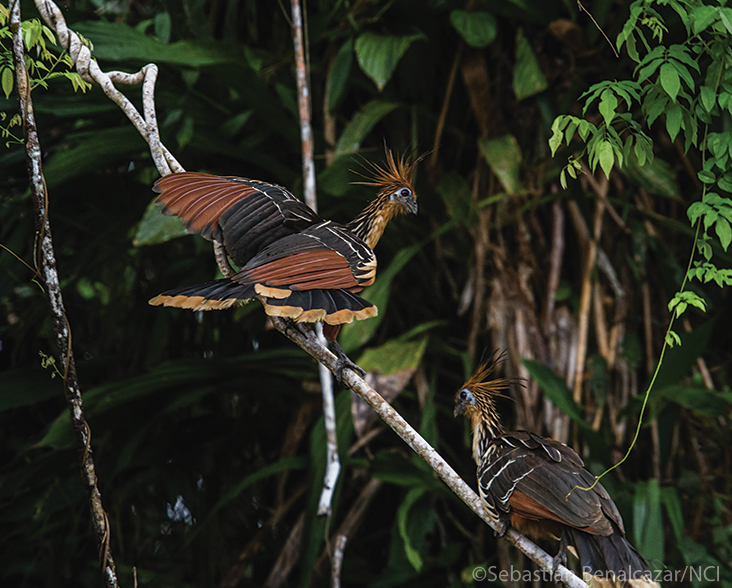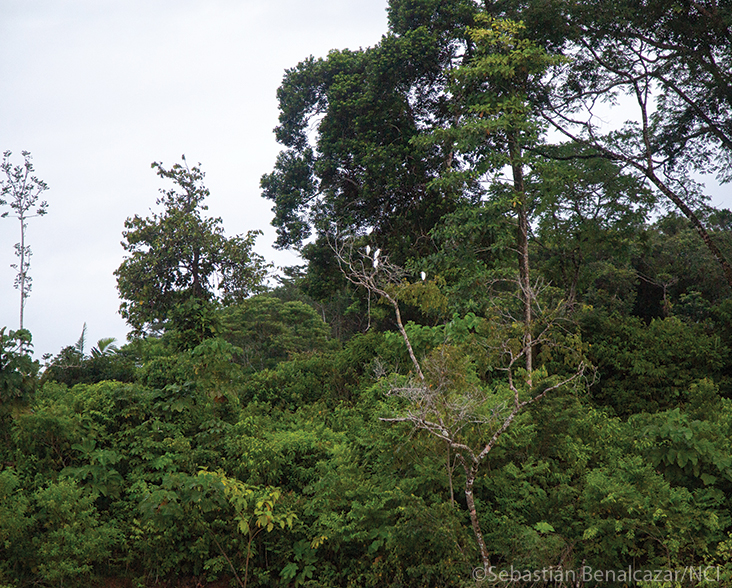Hoatzin
Species Data
Class: Aves
Order: Opisthocomiformes
Family: Opisthocomidae
Scientific Name: Opisthocomus hoazin
IUCN Red List status: Least Concern
Description
A unique and unmistakable bird, the Hoatzin is stocky with a long neck and small head, a long square tail, and short rounded wings. The underparts are pale buff on the throat and breast, merging into chestnut on the belly, flanks, thighs and vent. The upperparts are dark brown with bronze, olive or blue iridescence, bold white streaking on the nape and white edges to the wing coverts and scapulars. The leading edge to the wings is buff, and the primaries and underwing coverts are chestnut. The tail is iridescent blueish to greenish-brown with a broad, buff-white terminal band. The long, rufous erectile crest contrasts with the bright blue bare facial skin and red iris. The stout bill and short, thick legs are black. The sexes are similar, although females have a slightly shorter crest, and both are 62-70 cm from bill to tail and weigh 700-900g.
One particularly notable feature is the wing claws on the alula and major digits possessed by the dark brown downy chicks. These are used for locomotion and reduce in size as the chick grows.
Behaviour
The Hoatzin feeds at dawn and dusk. It’s folivorous, with new leaves and buds comprising 82% of their diet, flowers 10% and fruits 8%. Unique amongst birds, their food is slowly digested mainly in their enlarged crop and lower oesophagus, a digestive process known as microbial foregut fermentation. As they cannot chew, the muscular crop and lower oesophagus contain folds and ridges lined with cornified tissue to break down the leaves into pieces small enough for the bacteria to digest.
A consequence of this species’ anatomy and diet is a sedentary lifestyle. Much of the hottest part of the day is spent resting in trees while their food digests, and to accommodate a large foregut that accounts for up to 25% of their weight, the sternum is much reduced, limiting flight ability to weak flapping and gliding over short distances. The Hoatzin’s digestive system has also earned it the uncomplimentary nicknames of “stink bird” or “stinking Pheasant” after their strong, musky ‘fresh cow dung’ odour.
This species is highly social, often occurring in flocks of up to 100 individuals in the dry season. Nesting occurs in the wet season, the timing of which varies across their range. They are cooperative breeders consisting of a monogamous pair and up to six, usually male, adult or subadult helpers, mostly from previous broods, defending a small territory next to water. The female lays 2-4 eggs in an unlined, flat nest built of sticks overhanging water and the eggs are incubated by all group members for around 30-31 days. The chicks are fed regurgitated part-digested plant material by all the adults, growing slowly due to the low nutritional value of their diet. When threatened by a predator, the chicks fall into the water and swim before climbing back into the vegetation, aided by the claws on their wings. The young leave the nest at 2-3 weeks but are dependent on the adults for food for 2-3 months and cannot fly until around 60 days old.


Habitat
Arboreal, inhabiting vegetation, especially giant arums, along and overhanging rivers, streams, freshwater, brackish water and saltwater lakes, swamps, lagoons, and mangroves, mainly from around 5-200 m above sea level, though sometimes up to 500 m.
The Hoatzin occurs throughout the Amazon and Orinoco basins, spanning northern Brazil and east of the Andes in Venezuela, Colombia, Ecuador, Peru and Bolivia, as well as along the Atlantic coast in Guyana, Surinam, French Guiana and northern Brazil.
Threats and Conservation
Although the population trend is seemingly decreasing, this species is not globally threatened and is locally common throughout its range in suitable habitat. Therefore, it is categorised as Least Concern on the IUCN Red List.
The main threat to the Hoatzin is the loss of habitat to make way for agriculture, especially rice cultivation in Guyana, Surinam and Venezuela, and also hydrological projects. Other threats include lower breeding success due to disturbance from tourism, and persecution in French Guiana, which has decreased the population.
